brake TOYOTA AVALON 2019 (in English) User Guide
[x] Cancel search | Manufacturer: TOYOTA, Model Year: 2019, Model line: AVALON, Model: TOYOTA AVALON 2019Pages: 52, PDF Size: 3.61 MB
Page 13 of 52

11
OVERVIEW
FEATURES & OPERATIONS
TOYOTA SAFETY SENSE
SAFETY & EMERGENCY FEATURES
Electric parking brake
Steering lock release
Automatic operation Push the switch completely down or pull it completely up and
release to fully open or close. To stop the window partway, operate the \
switch in the
opposite direction.
Window lock switch Deactivates all passenger windows. Driver remains able to
operate all windows. Lightly press either side of the moonroof switch while opening/tilting i\
s in progress,
the moonroof stops partway.
The green indicator light on the engine switch will flash and a message \
will be
shown on the multi-information display. Press the engine switch while tu\
rning the
steering wheel left and right.
Push once to open completely.
Driver sideAutomatic modeManual mode (Brake HOLD switch)
Automatic (shift lever operation)
Manual To turn automatic mode ON, while vehicle is stopped, pull and hold switc\
h until
“EPB Shift Interlock Function Activated” displays in Multi-Information Display (MID).
While depressing brake, shifting into P position will automatically set \
the brake
and turn the parking brake indicator and parking brake light on. To rele\
ase brake,
depress brake and shift out of P. The indicator light and the light on t\
he switch turn
off.
To turn automatic mode OFF, push and hold parking brake switch until “\
EPB Shift
Interlock Function Deactivated” displays on the MID.
While vehicle is stopped and brake pedal is depressed, pull to set parki\
ng brake
and turn the parking brake indicator and parking brake light on. To rele\
ase, press
the brake pedal and push switch. The indicator light turns off.
Parking brake light
Standby indicatorOperated indicator
Parking brake light
Brake hold
The brake hold system keeps the brake applied when the shift lever is in\
D, S or N
with the system on and the brake pedal has been depressed to stop the ve\
hicle.
The system releases the brake when the accelerator pedal is depressed wi\
th the
shift lever in D or S to allow smooth start off.
Refer to the Owner’s Manual for limitations and more details.
2019_Avalon_QRG_V3_3_ML_0406.indd 114/12/18 3:14 PM
Page 26 of 52
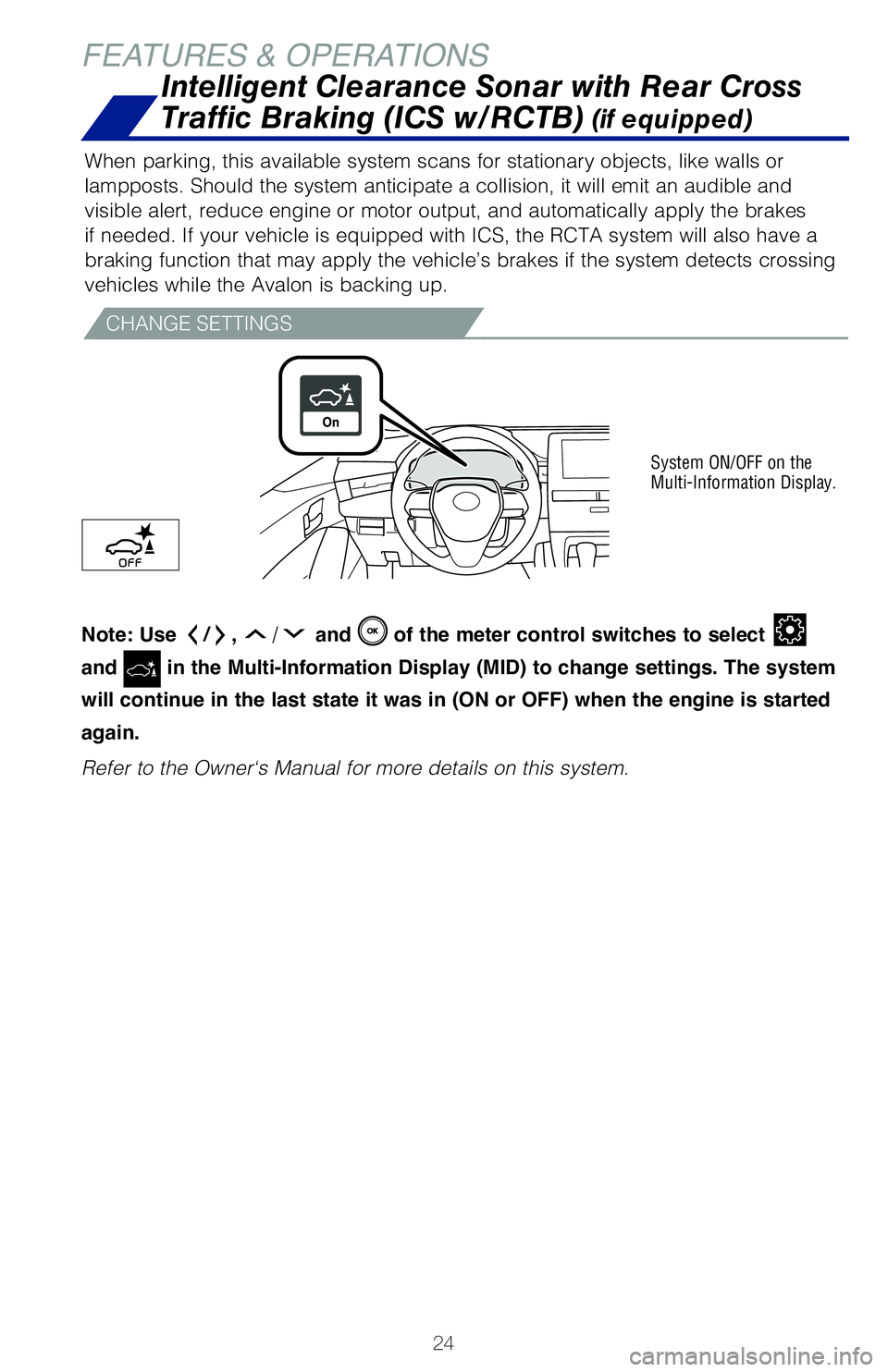
24
FEATURES & OPERATIONS
If the sensors detect an obstacle, the buzzer and MID display informs th\
e driver of
the approximate position and distance of the obstacle by illuminating co\
ntinuously
(far) or blinking (near).
Note: Use
/ , / and
of the meter control switches to select
and
in the Multi-Information Display (MID) to change settings. The system
will continue in the last state it was in (ON or OFF) when the engine is started
again.
Refer to section Intuitive parking assist in the Owner’s Manual for m\
ore details.
When parking, this available system scans for stationary objects, like w\
alls or
lampposts. Should the system anticipate a collision, it will emit an aud\
ible and
visible alert, reduce engine or motor output, and automatically apply th\
e brakes
if needed. If your vehicle is equipped with ICS, the RCTA system will al\
so have a
braking function that may apply the vehicle’s brakes if the system de\
tects crossing
vehicles while the Avalon is backing up.
Note: Use /, / and of the meter control switches to select
and
in the Multi-Information Display (MID) to change settings. The system
will continue in the last state it was in (ON or OFF) when the engine is started
again.
Refer to the Owner‘s Manual for more details on this system.
System ON/OFF on the
Multi-Information Display.
CHANGE SETTINGS
INTELLIGENT PARKING ASSIST (IF EQUIPPED)Intelligent Clearance Sonar with Rear Cross
Traffic Braking (ICS w/RCTB)
(if equipped)
2019_Avalon_QRG_V3_3_ML_0406.indd 244/12/18 3:14 PM
Page 27 of 52

25
If the sensors detect an obstacle, the buzzer and MID display informs th\
e driver of
the approximate position and distance of the obstacle by illuminating co\
ntinuously
(far) or blinking (near).
Note: Use
/, / and of the meter control switches to select
and
in the Multi-Information Display (MID) to change settings. The system
will continue in the last state it was in (ON or OFF) when the engine is started
again.
Refer to section Intuitive parking assist in the Owner’s Manual for m\
ore details.
When parking, this available system scans for stationary objects, like w\
alls or
lampposts. Should the system anticipate a collision, it will emit an aud\
ible and
visible alert, reduce engine or motor output, and automatically apply th\
e brakes
if needed. If your vehicle is equipped with ICS, the RCTA system will al\
so have a
braking function that may apply the vehicle’s brakes if the system de\
tects crossing
vehicles while the Avalon is backing up.
Note: Use / , / and
of the meter control switches to select
and in the Multi-Information Display (MID) to change settings. The system
will continue in the last state it was in (ON or OFF) when the engine is started
again.
Refer to the Owner‘s Manual for more details on this system.
System ON/OFF on the
Multi-Information Display.
INTELLIGENT PARKING ASSIST (IF EQUIPPED)Intelligent Clearance Sonar with Rear Cross
Traffic Braking (ICS w/RCTB)
(if equipped)
OVERVIEW
FEATURES & OPERATIONS
TOYOTA SAFETY SENSE
SAFETY & EMERGENCY FEATURES
Front
center sensor
Rear
center sensor
Corner sensors
(front)
Corner sensors
(front)
Corner sensors
(front)
Corner sensors
(front)
2019_Avalon_QRG_V3_3_ML_0406.indd 254/12/18 3:14 PM
Page 30 of 52
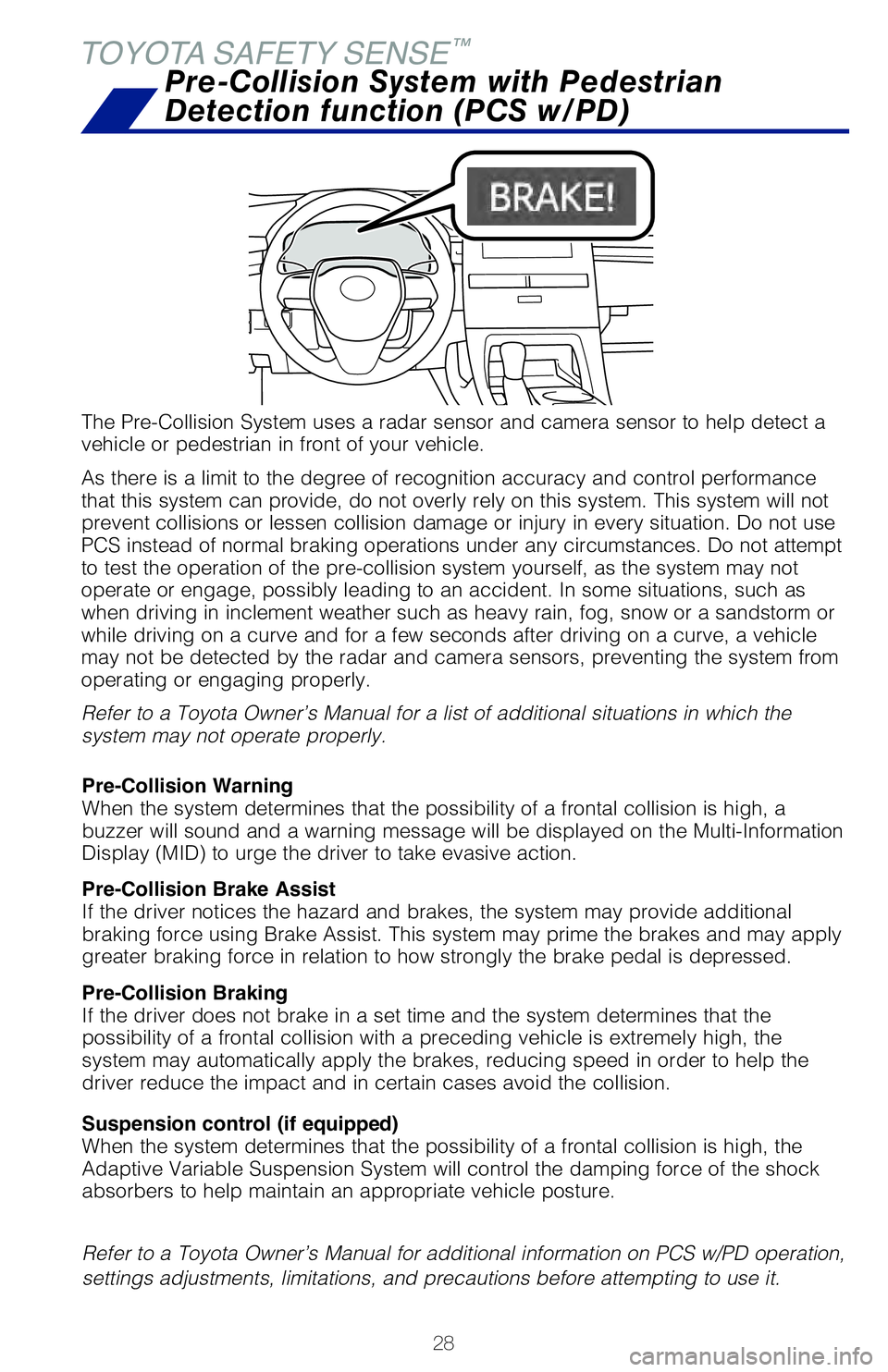
28
The Pre-Collision System uses a radar sensor and camera sensor to help d\
etect a
vehicle or pedestrian in front of your vehicle.
As there is a limit to the degree of recognition accuracy and control pe\
rformance
that this system can provide, do not overly rely on this system. This sy\
stem will not
prevent collisions or lessen collision damage or injury in every situati\
on. Do not use
PCS instead of normal braking operations under any circumstances. Do not\
attempt
to test the operation of the pre-collision system yourself, as the syste\
m may not
operate or engage, possibly leading to an accident. In some situations, \
such as
when driving in inclement weather such as heavy rain, fog, snow or a san\
dstorm or
while driving on a curve and for a few seconds after driving on a curve,\
a vehicle
may not be detected by the radar and camera sensors, preventing the syst\
em from
operating or engaging properly.
Refer to a Toyota Owner’s Manual for a list of additional situations \
in which the
system may not operate properly.Refer to a Toyota Owner’s Manual for additional information on PCS w/\
PD operation,
settings adjustments, limitations, and precautions before attempting to \
use it. Pre-Collision Warning
When the system determines that the possibility of a frontal collision i\
s high, a
buzzer will sound and a warning message will be displayed on the Multi-I\
nformation
Display (MID) to urge the driver to take evasive action.
Pre-Collision Brake Assist
If the driver notices the hazard and brakes, the system may provide addi\
tional
braking force using Brake Assist. This system may prime the brakes and m\
ay apply
greater braking force in relation to how strongly the brake pedal is dep\
ressed.
Pre-Collision Braking
If the driver does not brake in a set time and the system determines tha\
t the
possibility of a frontal collision with a preceding vehicle is extremely\
high, the
system may automatically apply the brakes, reducing speed in order to he\
lp the
driver reduce the impact and in certain cases avoid the collision.
Pre-Collision System with Pedestrian
Detection function (PCS w/PD)
TOYOTA SAFETY SENSE
™
CHANGING THE PCS ALERT TIMING
(1) Press “
” switches and select from the Multi-Information Display (MID).
(2) Press “ ” or “ ” switches and select
from the MID and then press
“”. The setting screen is displayed.
(3) Press “
” each time to change the setting. Each time it is pressed, the
response to the PCS alert timing changes as shown above. You can press “\
” to
go back to the menu.
Note: PCS is enabled each time the engine switch is turned to Ignition On.
The system can be disabled/enabled and the alert timing of the system can be
changed. (Alert timing only, brake operation remains the same). As part of the Pre-Collision System, this function is also designed to f\
irst provide an
alert and then automatic braking if needed.
In certain conditions, the PCS system included with the TSS-P package ma\
y also
help to detect a pedestrian in front of your vehicle. With Toyota Safety\
Sense™ P,
PCS uses an in-vehicle camera and front-grill mounted millimeter-wave ra\
dar to
help detect a pedestrian in front of your vehicle in certain conditions.\
The in-vehicle
camera of PCS detects a potential pedestrian based on size, profile, and\
motion of
the detected pedestrian. However, a pedestrian may not be detected depen\
ding
on the conditions, including the surrounding brightness and the motion, \
posture,
size, and angle of the potential detected pedestrian, preventing the sys\
tem from
operating or engaging. Refer to a Toyota Owner’s Manual for additional information.
PCS PEDESTRIAN DETECTION FUNCTION
Suspension control (if equipped)
When the system determines that the possibility of a frontal collision i\
s high, the
Adaptive Variable Suspension System will control the damping force of th\
e shock
absorbers to help maintain an appropriate vehicle posture.
2019_Avalon_QRG_V3_3_ML_0406.indd 284/12/18 3:14 PM
Page 31 of 52
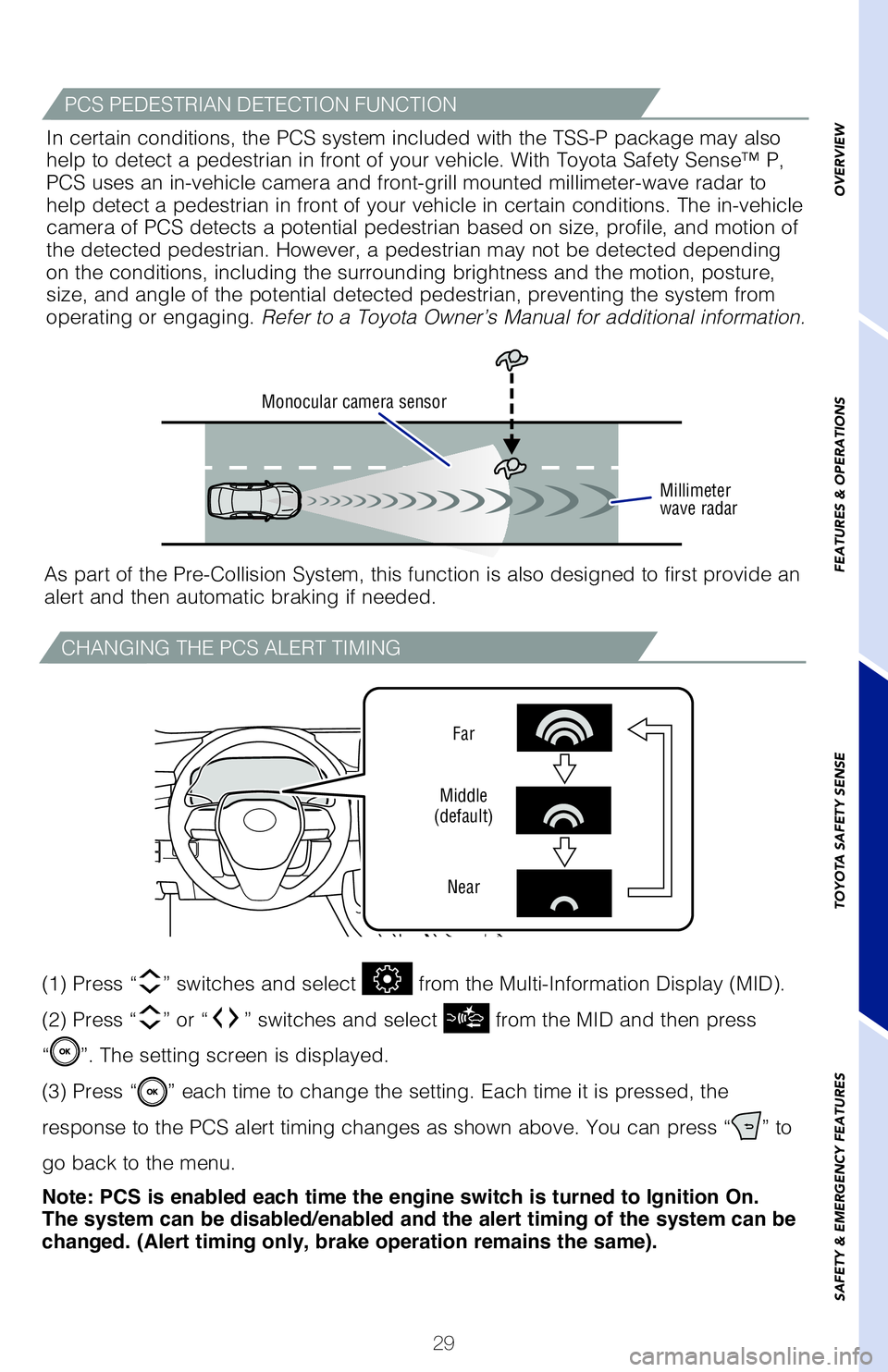
29
The Pre-Collision System uses a radar sensor and camera sensor to help d\
etect a
vehicle or pedestrian in front of your vehicle.
As there is a limit to the degree of recognition accuracy and control pe\
rformance
that this system can provide, do not overly rely on this system. This sy\
stem will not
prevent collisions or lessen collision damage or injury in every situati\
on. Do not use
PCS instead of normal braking operations under any circumstances. Do not\
attempt
to test the operation of the pre-collision system yourself, as the syste\
m may not
operate or engage, possibly leading to an accident. In some situations, \
such as
when driving in inclement weather such as heavy rain, fog, snow or a san\
dstorm or
while driving on a curve and for a few seconds after driving on a curve,\
a vehicle
may not be detected by the radar and camera sensors, preventing the syst\
em from
operating or engaging properly.
Refer to a Toyota Owner’s Manual for a list of additional situations \
in which the
system may not operate properly.Refer to a Toyota Owner’s Manual for additional information on PCS w/\
PD operation,
settings adjustments, limitations, and precautions before attempting to \
use it. Pre-Collision Warning
When the system determines that the possibility of a frontal collision i\
s high, a
buzzer will sound and a warning message will be displayed on the Multi-I\
nformation
Display (MID) to urge the driver to take evasive action.
Pre-Collision Brake Assist
If the driver notices the hazard and brakes, the system may provide addi\
tional
braking force using Brake Assist. This system may prime the brakes and m\
ay apply
greater braking force in relation to how strongly the brake pedal is dep\
ressed.
Pre-Collision Braking
If the driver does not brake in a set time and the system determines tha\
t the
possibility of a frontal collision with a preceding vehicle is extremely\
high, the
system may automatically apply the brakes, reducing speed in order to he\
lp the
driver reduce the impact and in certain cases avoid the collision.
CHANGING THE PCS ALERT TIMING
Far
Middle
(default)
Near
(1) Press “” switches and select from the Multi-Information Display (MID).
(2) Press “
” or “” switches and select from the MID and then press
“
”. The setting screen is displayed.
(3) Press “
” each time to change the setting. Each time it is pressed, the
response to the PCS alert timing changes as shown above. You can press “\
” to
go back to the menu.
Note: PCS is enabled each time the engine switch is turned to Ignition On.
The system can be disabled/enabled and the alert timing of the system can be
changed. (Alert timing only, brake operation remains the same).
Monocular camera sensor
Millimeter
wave radar
As part of the Pre-Collision System, this function is also designed to f\
irst provide an
alert and then automatic braking if needed.In certain conditions, the PCS system included with the TSS-P package ma\
y also
help to detect a pedestrian in front of your vehicle. With Toyota Safety\
Sense™ P,
PCS uses an in-vehicle camera and front-grill mounted millimeter-wave ra\
dar to
help detect a pedestrian in front of your vehicle in certain conditions.\
The in-vehicle
camera of PCS detects a potential pedestrian based on size, profile, and\
motion of
the detected pedestrian. However, a pedestrian may not be detected depen\
ding
on the conditions, including the surrounding brightness and the motion, \
posture,
size, and angle of the potential detected pedestrian, preventing the sys\
tem from
operating or engaging. Refer to a Toyota Owner’s Manual for additional information.
PCS PEDESTRIAN DETECTION FUNCTION
Suspension control (if equipped)
When the system determines that the possibility of a frontal collision i\
s high, the
Adaptive Variable Suspension System will control the damping force of th\
e shock
absorbers to help maintain an appropriate vehicle posture.
OVERVIEW
FEATURES & OPERATIONS
TOYOTA SAFETY SENSE
SAFETY & EMERGENCY FEATURES
2019_Avalon_QRG_V3_3_ML_0406.indd 294/12/18 3:14 PM
Page 36 of 52
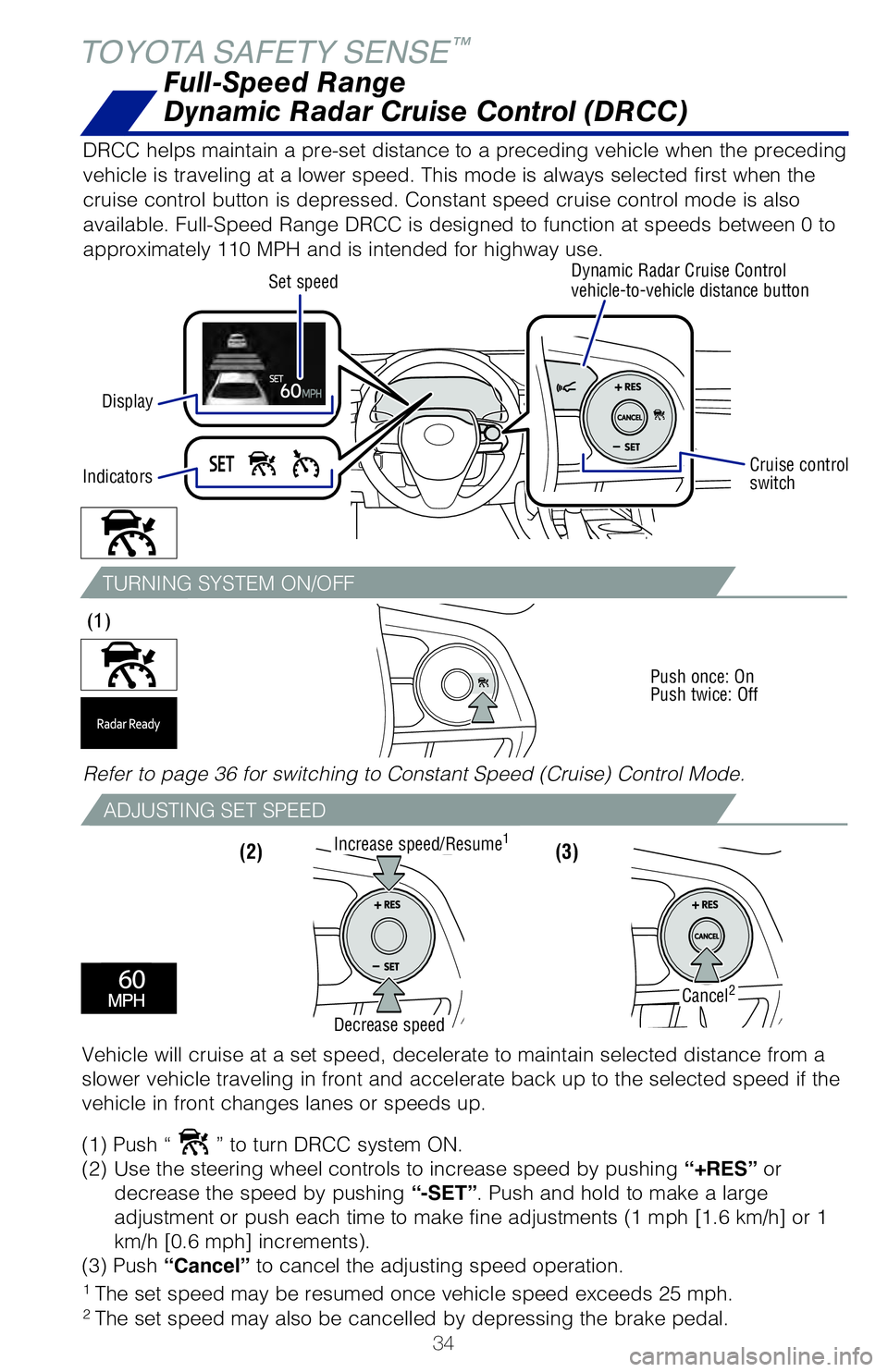
34
TURNING SYSTEM ON/OFF
ADJUSTING SET SPEED
(3)
(1)
Push once: On
Push twice: Off
(2)
TOYOTA SAFETY SENSE™
ADJUSTING DISTANCE
This mode employs a radar sensor to detect the presence of a preceding v\
ehicle
up to approximately 328 ft (100m) ahead, determines the current vehicle-to-vehicle
following distance and operates to maintain a preset following distance \
from the
vehicle ahead. These distances vary based on vehicle speed.
(1) Constant speed cruising when there are no vehicles ahead
The vehicle travels at the speed set by the driver. The desired vehicle-\
to-
vehicle distance can also be set by operating the vehicle-to-vehicle dis\
tance
control.
(2) Deceleration cruising and follow-up cruising when a preceding vehicle
driving slower than the set speed appears When a vehicle is detected running ahead of you, the system automaticall\
y
decelerates your vehicle. When a greater reduction in vehicle speed is
necessary, the system applies the brakes (the brake lights will come on at this
time). The system will respond to changes in the speed of the vehicle ahead
in order to maintain the vehicle-to-vehicle distance set by the driver. \
A warning
tone warns you when the system cannot decelerate sufficiently to prevent\
your
vehicle from closing in on the vehicle ahead.
Note: Vehicle-to-vehicle distance will close in when traveling on long downhill
slopes.
1 The set speed may be resumed once vehicle speed exceeds 25 mph.2 The set speed may also be cancelled by depressing the brake pedal.
Full-Speed Range
Dynamic Radar Cruise Control (DRCC)
DRCC helps maintain a pre-set distance to a preceding vehicle when the p\
receding
vehicle is traveling at a lower speed. This mode is always selected firs\
t when the
cruise control button is depressed. Constant speed cruise control mode i\
s also
available. Full-Speed Range DRCC is designed to function at speeds betwe\
en 0 to
approximately 110 MPH and is intended for highway use.
Display Set speed
Dynamic Radar Cruise Control
vehicle-to-vehicle distance button
Cruise control
switch
Indicators
Refer to page 36 for switching to Constant Speed (Cruise) Control Mode\
.
Vehicle will cruise at a set speed, decelerate to maintain selected dist\
ance from a
slower vehicle traveling in front and accelerate back up to the selected\
speed if the
vehicle in front changes lanes or speeds up.
(1) Push “
” to turn DRCC system ON.
(2) Use the steering wheel controls to increase speed by pushing “+RES” or
decrease the speed by pushing “-SET”. Push and hold to make a large
adjustment or push each time to make fine adjustments (1 mph [1.6 km/h] or 1
km/h [0.6 mph] increments).
(3) Push “Cancel” to cancel the adjusting speed operation.
Increase speed/Resume1
Cancel2
Decrease speed
2019_Avalon_QRG_V3_3_ML_0406.indd 344/12/18 3:14 PM
Page 37 of 52
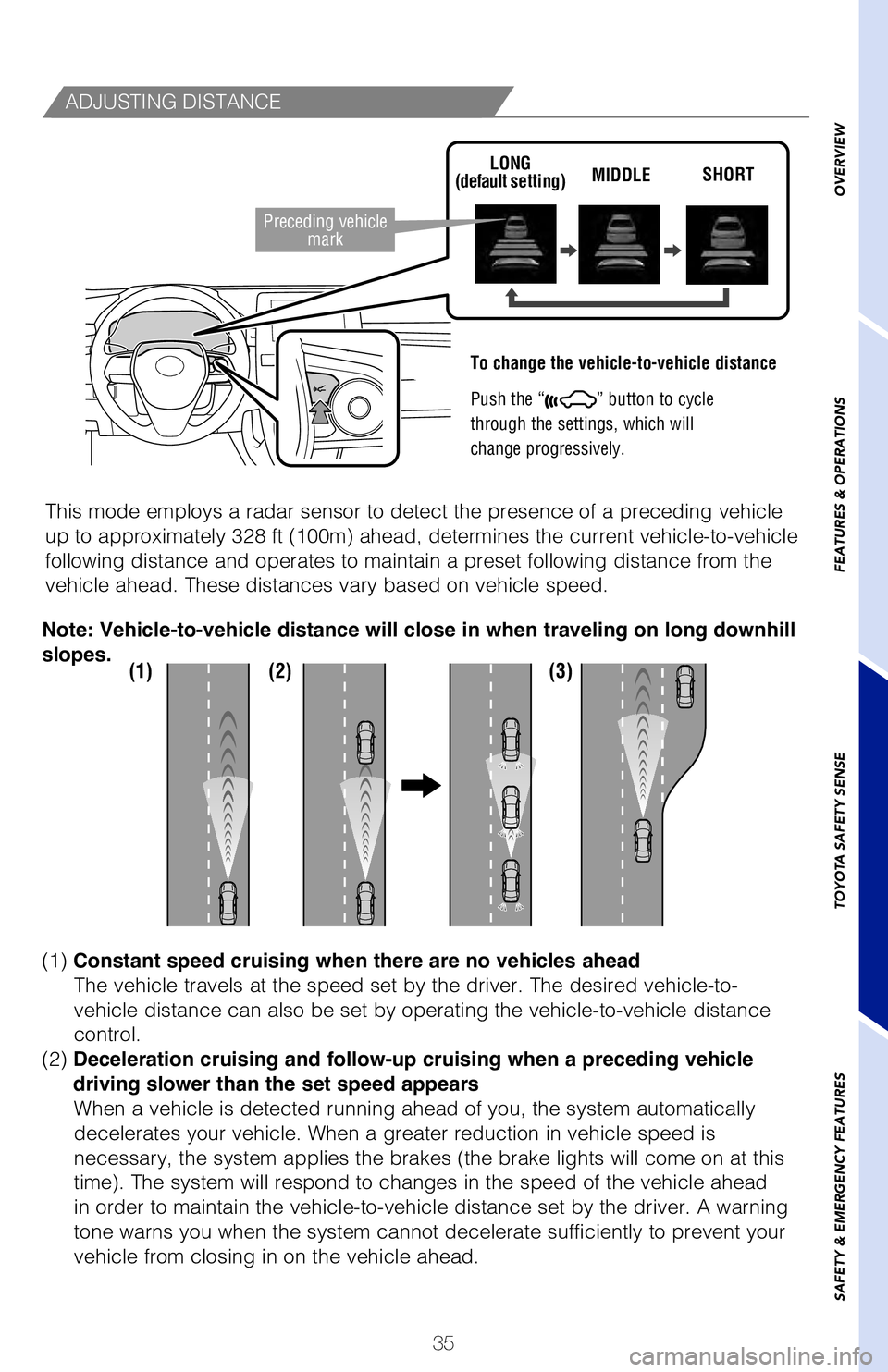
35
ADJUSTING DISTANCE
To change the vehicle-to-vehicle distance
Push the “
” button to cycle
through the settings, which will
change progressively.
This mode employs a radar sensor to detect the presence of a preceding v\
ehicle
up to approximately 328 ft (100m) ahead, determines the current vehicle-to-vehicle
following distance and operates to maintain a preset following distance \
from the
vehicle ahead. These distances vary based on vehicle speed.
LONG
(default setting) MIDDLE
SHORT
(1) (2) (3)
(1) Constant speed cruising when there are no vehicles ahead
The vehicle travels at the speed set by the driver. The desired vehicle-\
to-
vehicle distance can also be set by operating the vehicle-to-vehicle dis\
tance
control.
(2) Deceleration cruising and follow-up cruising when a preceding vehicle
driving slower than the set speed appears When a vehicle is detected running ahead of you, the system automaticall\
y
decelerates your vehicle. When a greater reduction in vehicle speed is
necessary, the system applies the brakes (the brake lights will come on at this
time). The system will respond to changes in the speed of the vehicle ahead
in order to maintain the vehicle-to-vehicle distance set by the driver. \
A warning
tone warns you when the system cannot decelerate sufficiently to prevent\
your
vehicle from closing in on the vehicle ahead.
Note: Vehicle-to-vehicle distance will close in when traveling on long downhill
slopes.
1 The set speed may be resumed once vehicle speed exceeds 25 mph.2 The set speed may also be cancelled by depressing the brake pedal.
Preceding vehicle
mark
Full-Speed Range
Dynamic Radar Cruise Control (DRCC)
DRCC helps maintain a pre-set distance to a preceding vehicle when the p\
receding
vehicle is traveling at a lower speed. This mode is always selected firs\
t when the
cruise control button is depressed. Constant speed cruise control mode i\
s also
available. Full-Speed Range DRCC is designed to function at speeds betwe\
en 0 to
approximately 110 MPH and is intended for highway use.
Dynamic Radar Cruise Control
vehicle-to-vehicle distance button
Cruise control
switch
Refer to page 36 for switching to Constant Speed (Cruise) Control Mode\
.
Vehicle will cruise at a set speed, decelerate to maintain selected dist\
ance from a
slower vehicle traveling in front and accelerate back up to the selected\
speed if the
vehicle in front changes lanes or speeds up.
(1) Push “
” to turn DRCC system ON.
(2) Use the steering wheel controls to increase speed by pushing “+RES” or
decrease the speed by pushing “-SET”. Push and hold to make a large
adjustment or push each time to make fine adjustments (1 mph [1.6 km/h] or 1
km/h [0.6 mph] increments).
(3) Push “Cancel” to cancel the adjusting speed operation.
OVERVIEW
FEATURES & OPERATIONS
TOYOTA SAFETY SENSE
SAFETY & EMERGENCY FEATURES
2019_Avalon_QRG_V3_3_ML_0406.indd 354/12/18 3:14 PM
Page 38 of 52
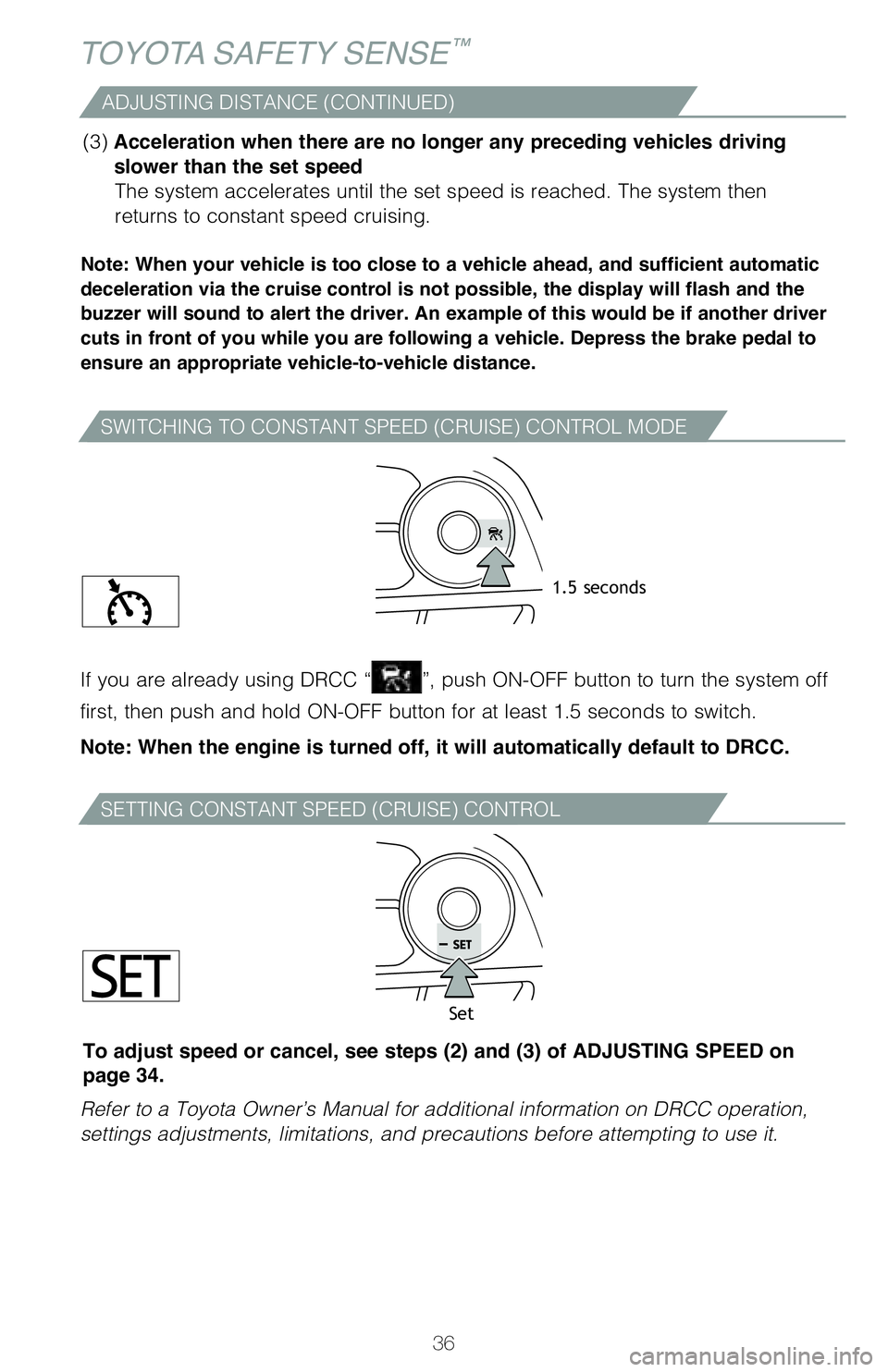
36
SWITCHING TO CONSTANT SPEED (CRUISE) CONTROL MODE
SETTING CONSTANT SPEED (CRUISE) CONTROL
Note: When your vehicle is too close to a vehicle ahead, and sufficient automatic
deceleration via the cruise control is not possible, the display will flash and the
buzzer will sound to alert the driver. An example of this would be if another driver
cuts in front of you while you are following a vehicle. Depress the brake pedal to
ensure an appropriate vehicle-to-vehicle distance.
If you are already using DRCC “”, push ON-OFF button to turn the system off
first, then push and hold ON-OFF button for at least 1.5 seconds to swit\
ch.
Note: When the engine is turned off, it will automatically default to DRCC.
Refer to a Toyota Owner’s Manual for additional information on DRCC o\
peration,
settings adjustments, limitations, and precautions before attempting to \
use it.
1.5 seconds
Set
(3) Acceleration when there are no longer any preceding vehicles driving
slower than the set speed The system accelerates until the set speed is reached. The system then
returns to constant speed cruising.
TOYOTA SAFETY SENSE™
AHB is a safety system designed to help drivers see more of what’s ah\
ead at
nighttime and reduce glare for oncoming drivers. When enabled, AHB uses \
an
in-vehicle camera to help detect the headlights of oncoming vehicles and\
tail lights
of preceding vehicles, then automatically switches between high and low \
beams
as appropriate to provide the most light possible and enhance forward vi\
sibility.
By using high beams more frequently, the system may allow earlier detect\
ion of
pedestrians and obstacles.
Refer to a Toyota Owner’s Manual for additional information on AHB op\
eration,
settings adjustments, limitations, and precautions before attempting to \
use it.
(1) With the engine switch in IGNITION ON mode, turn the headlight switch to “AUTO” position.
(2) Push lever away from you.
(3) Press the “
” switch.
The AHB indicator will come on when the headlights are turned on automat\
ically
to indicate that the system is active.
Note: Pull the lever back toward you to turn the AHB system off.
The AHB indicator will turn off. To turn switch to “
” position and the manual
high beam indicator “
” turns on.
When all of these conditions are met, high beams will be automatically t\
urned on
(after approximately 1 second): • Vehicle speed is above approximately 21 mph (34 km/h.)
• The area ahead of the vehicle is dark.
• There are no oncoming or preceding vehicles with headlights or tail\
lights turned on.
• There are few street lights on the road ahead.
If any of these conditions occur, the system is designed to automaticall\
y turn off
high beams: • Vehicle speed drops below approximately 17 mph (27 km/h.)
• The area ahead of the vehicle is not dark.
• Oncoming or preceding vehicles have headlights or tail lightsturned on.
• There are many streetlights on the road ahead.
ACTIVATING THE AHB SYSTEM
CONDITIONS WHERE AHB WILL TURN ON/OFF AUTOMATICALLY
To adjust speed or cancel, see steps (2) and (3) of ADJUSTING SPEED on
page 34.
ADJUSTING DISTANCE (CONTINUED)
2019_Avalon_QRG_V3_3_ML_0406.indd 364/12/18 3:14 PM
Page 39 of 52
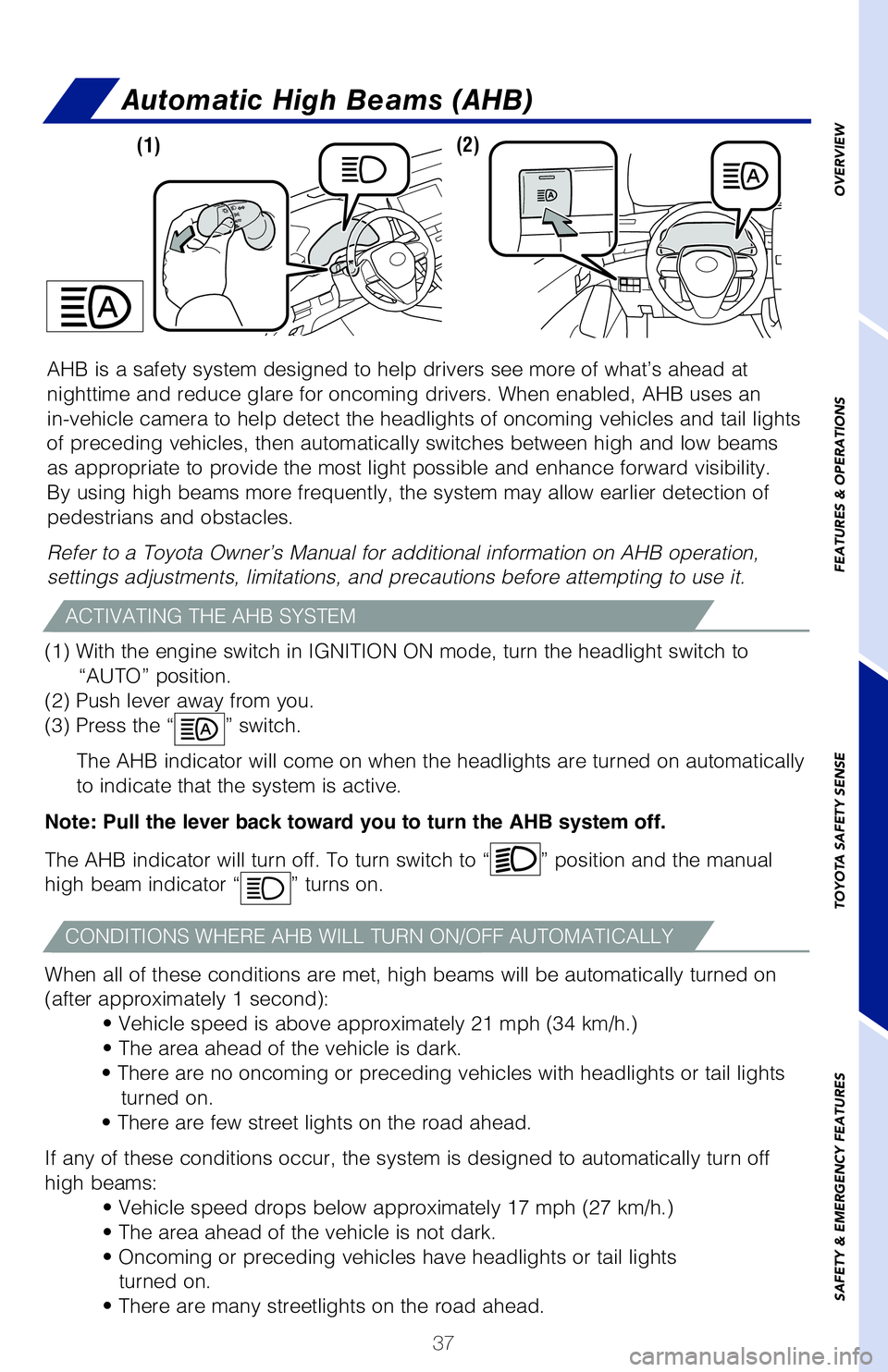
37
Note: When your vehicle is too close to a vehicle ahead, and sufficient automatic
deceleration via the cruise control is not possible, the display will flash and the
buzzer will sound to alert the driver. An example of this would be if another driver
cuts in front of you while you are following a vehicle. Depress the brake pedal to
ensure an appropriate vehicle-to-vehicle distance.
If you are already using DRCC “”, push ON-OFF button to turn the system off
first, then push and hold ON-OFF button for at least 1.5 seconds to swit\
ch.
Note: When the engine is turned off, it will automatically default to DRCC.
Refer to a Toyota Owner’s Manual for additional information on DRCC o\
peration,
settings adjustments, limitations, and precautions before attempting to \
use it. (3)
Acceleration when there are no longer any preceding vehicles driving
slower than the set speed The system accelerates until the set speed is reached. The system then
returns to constant speed cruising.
AHB is a safety system designed to help drivers see more of what’s ah\
ead at
nighttime and reduce glare for oncoming drivers. When enabled, AHB uses \
an
in-vehicle camera to help detect the headlights of oncoming vehicles and\
tail lights
of preceding vehicles, then automatically switches between high and low \
beams
as appropriate to provide the most light possible and enhance forward vi\
sibility.
By using high beams more frequently, the system may allow earlier detect\
ion of
pedestrians and obstacles.
Refer to a Toyota Owner’s Manual for additional information on AHB op\
eration,
settings adjustments, limitations, and precautions before attempting to \
use it.
Automatic High Beams (AHB)
(1) With the engine switch in IGNITION ON mode, turn the headlight switch to “AUTO” position.
(2) Push lever away from you.
(3) Press the “
” switch.
The AHB indicator will come on when the headlights are turned on automat\
ically
to indicate that the system is active.
Note: Pull the lever back toward you to turn the AHB system off.
The AHB indicator will turn off. To turn switch to “
” position and the manual
high beam indicator “
” turns on.
When all of these conditions are met, high beams will be automatically t\
urned on
(after approximately 1 second): • Vehicle speed is above approximately 21 mph (34 km/h.)
• The area ahead of the vehicle is dark.
• There are no oncoming or preceding vehicles with headlights or tail\
lights turned on.
• There are few street lights on the road ahead.
If any of these conditions occur, the system is designed to automaticall\
y turn off
high beams: • Vehicle speed drops below approximately 17 mph (27 km/h.)
• The area ahead of the vehicle is not dark.
• Oncoming or preceding vehicles have headlights or tail lightsturned on.
• There are many streetlights on the road ahead.
ACTIVATING THE AHB SYSTEM
CONDITIONS WHERE AHB WILL TURN ON/OFF AUTOMATICALLY
To adjust speed or cancel, see steps (2) and (3) of ADJUSTING SPEED on
page 34.
(2) (1)
OVERVIEW
FEATURES & OPERATIONS
TOYOTA SAFETY SENSE
SAFETY & EMERGENCY FEATURES
2019_Avalon_QRG_V3_3_ML_0406.indd 374/12/18 3:14 PM
Page 44 of 52
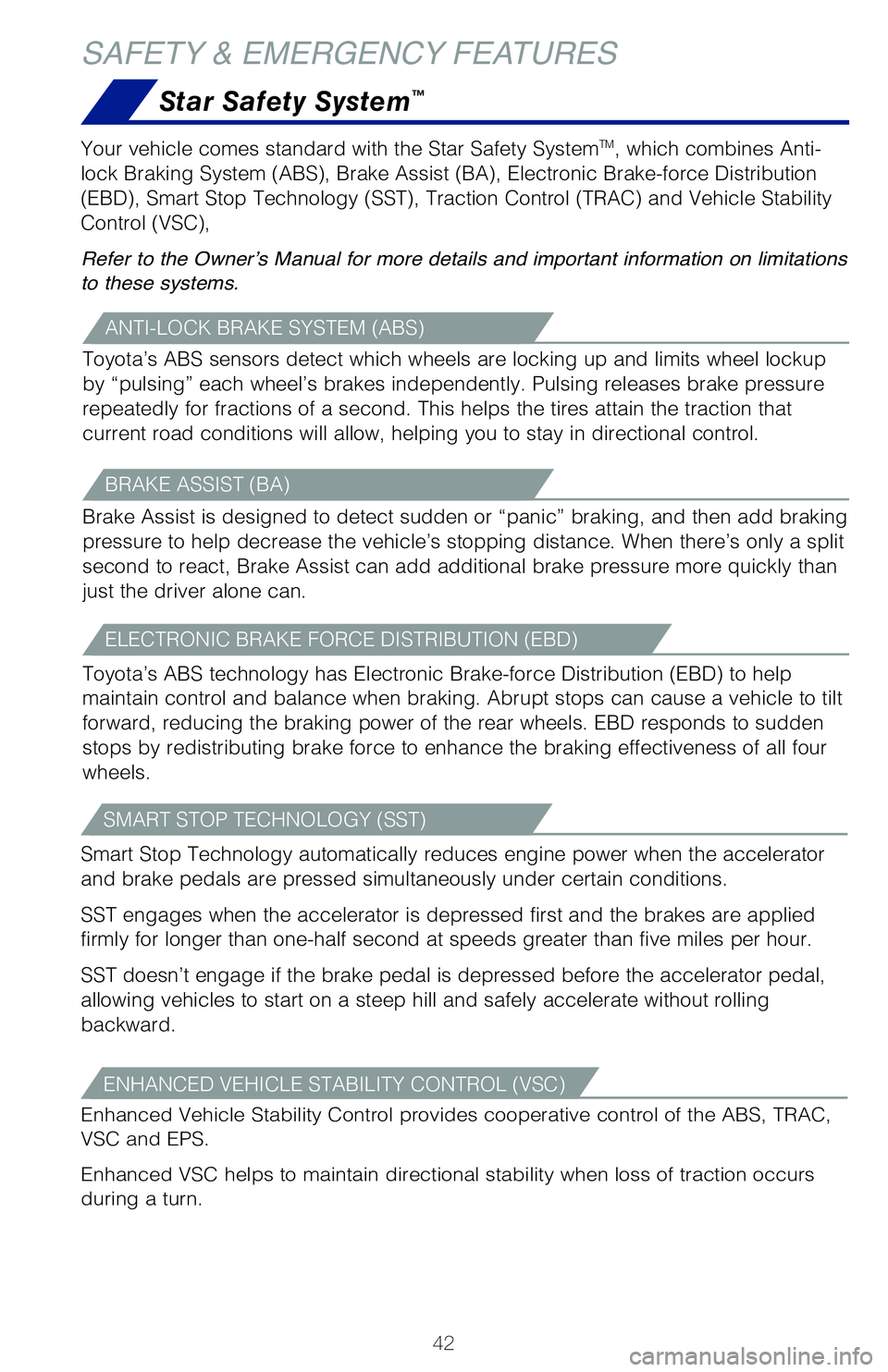
42
There are two types of Toyota floor mats: carpeted and all-weather. Each\
vehicle
has model-specific floor mats. Installation is easy.
To keep your floor mat properly positioned, follow these steps:
• Only use Toyota floor mats designed for your specific model.
• Use only one floor mat at a time, using the retaining hooks to keep\
the mat in place.
• Install floor mats right side up.
SAFETY & EMERGENCY FEATURES
Star Safety System™
ANTI-LOCK BRAKE SYSTEM (ABS)
Toyota’s ABS sensors detect which wheels are locking up and limits wh\
eel lockup
by “pulsing” each wheel’s brakes independently. Pulsing release\
s brake pressure
repeatedly for fractions of a second. This helps the tires attain the tr\
action that
current road conditions will allow, helping you to stay in directional c\
ontrol.
BRAKE ASSIST (BA)
Brake Assist is designed to detect sudden or “panic” braking, and \
then add braking
pressure to help decrease the vehicle’s stopping distance. When there\
’s only a split
second to react, Brake Assist can add additional brake pressure more qui\
ckly than
just the driver alone can.
TRACTION CONTROL (TRAC)
VSC helps prevent loss of traction during cornering by reducing engine p\
ower, and
Traction Control helps maintain traction on loose gravel and wet, icy, o\
r uneven
surfaces by applying brake force to the spinning wheel(s).
Toyota’s TRAC sensors are activated when one of the drive wheels star\
ts to slip.
TRAC limits engine output and applies the brakes to the spinning wheel. \
This
transfers power to the wheels that still have traction to help keep you \
on track.
ELECTRONIC BRAKE FORCE DISTRIBUTION (EBD)
Toyota’s ABS technology has Electronic Brake-force Distribution (EBD) to help
maintain control and balance when braking. Abrupt stops can cause a vehi\
cle to tilt
forward, reducing the braking power of the rear wheels. EBD responds to \
sudden
stops by redistributing brake force to enhance the braking effectiveness\
of all four
wheels.
Your vehicle comes standard with the Star Safety System
TM, which combines Anti-
lock Braking System (ABS), Brake Assist (BA), Electronic Brake-force Distribution
(EBD), Smart Stop Technology (SST), Traction Control (TRAC) and Vehicle Stability
Control (VSC),
Refer to the Owner’s Manual for more details and important information on limitations
to these systems.
SMART STOP TECHNOLOGY (SST)
Smart Stop Technology automatically reduces engine power when the accele\
rator
and brake pedals are pressed simultaneously under certain conditions.
SST engages when the accelerator is depressed first and the brakes are a\
pplied
firmly for longer than one-half second at speeds greater than five miles\
per hour.
SST doesn’t engage if the brake pedal is depressed before the acceler\
ator pedal,
allowing vehicles to start on a steep hill and safely accelerate without\
rolling
backward.
ENHANCED VEHICLE STABILITY CONTROL (VSC)
Enhanced Vehicle Stability Control provides cooperative control of the A\
BS, TRAC,
VSC and EPS.
Enhanced VSC helps to maintain directional stability when loss of tracti\
on occurs
during a turn.
2019_Avalon_QRG_V3_3_ML_0406.indd 424/12/18 3:14 PM